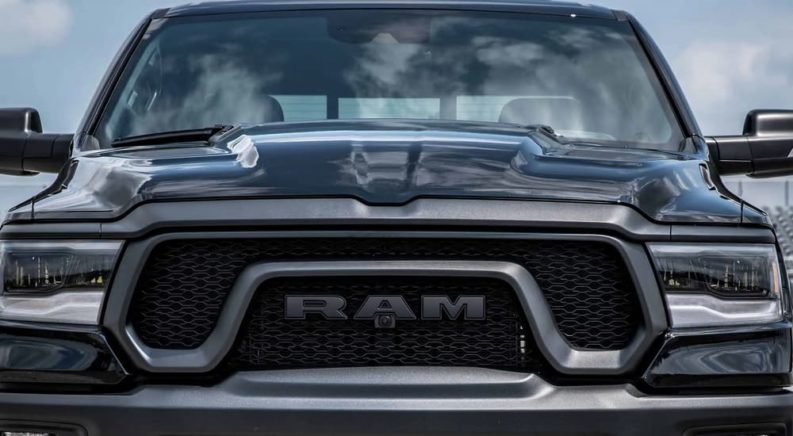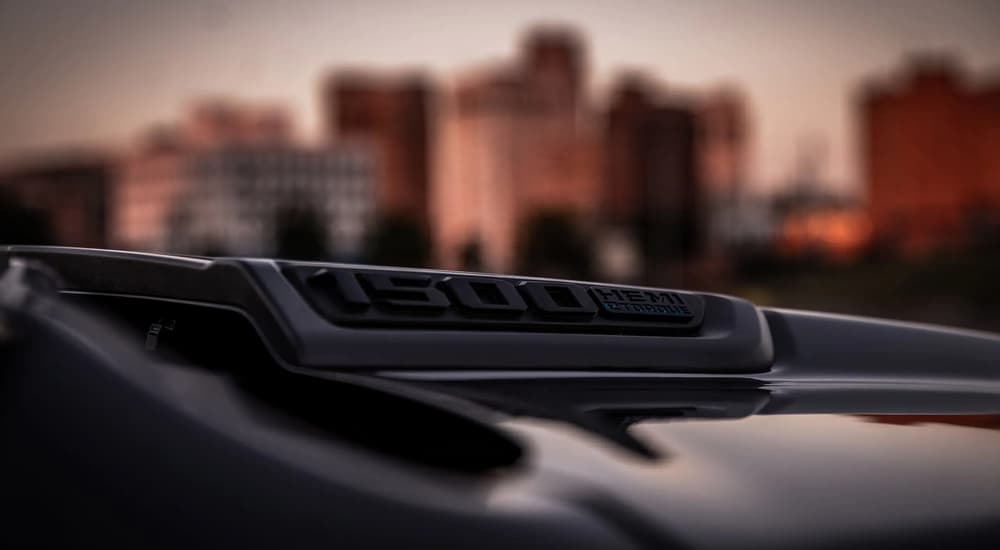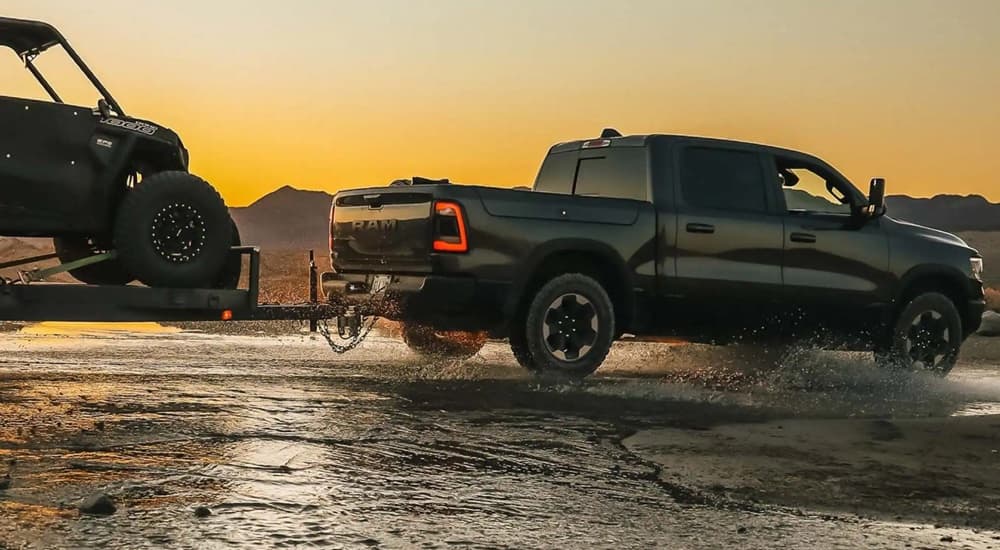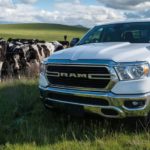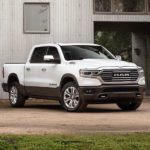If you’re looking for a full hybrid or even a plug-in hybrid version of the powerful Ram 1500, you’re out of luck. However, that doesn’t mean there aren’t any hybrid Ram trucks for sale. In fact, you might not even realize just how many hybrid trucks Ram builds, given how it markets its eTorque system. While not everyone needs to know what an “eTorque” is or the different types of hybrid systems that are out there, it’s worth it if you’re someone who really wants to understand the kinds of engines that are being offered in modern trucks.
Ram has always been one of the leaders when it comes to marketing its engines just as much as its trucks––that’s why so many people recognize the phrase “HEMI V8” even if they’re not a big fan of Ram trucks. The brand’s latest push has been the development and popularization of the eTorque system and how it can help boost power and performance for its trucks. Let’s take a look at what the eTorque system is, exactly, and the different types of hybrid engines out there so that we can better understand whether this is pure marketing hype or if it’s a development that has made for a better Ram pickup.
The eTorque Mild Hybrid System
We’ll start off by looking at the eTorque system on the Ram 1500 specifically, then look at hybrid engines in general, and then come back to the Ram truck. For starters, the eTorque system is a mild hybrid (more on that below) that replaces the alternator found on a conventional gas engine with a small, belt-driven motor generator. Standard gas-powered engines use an alternator to convert power from the engine into electricity, which is then used to keep the battery charged and to send power to other electrical systems in the vehicle.
The eTorque system instead uses the motor generator to do the same tasks but also to boost overall performance. It still does what an alternator would do by keeping the battery charged and working with the electrical systems in the Ram truck, but it also boosts power to the engine for improved capability. You might not feel this in terms of greater horsepower or torque at the wheels, but it does make a difference (more specifics on that down below). This motor works with a small battery pack, and not only does it get power from the engine, but it can also produce power through regenerative braking.
Regenerative braking uses energy that would otherwise be wasted when you slow down or bring your vehicle to a stop and instead charges the small battery pack with it. This makes the eTorque Ram trucks more efficient and allows them to utilize the massive amounts of energy generated and wasted by vehicles on the road. The difference in fuel economy isn’t massive since eTorque isn’t a full hybrid system, but it is certainly there.
Different Types of Hybrid Powertrains
Many people throw around the word “hybrid” when talking about different types of vehicles without fully accounting for the variety of hybrid systems out there. You’ll find three common types of hybrid powertrains on vehicles, including a growing number of trucks and SUVs, which can all boost the performance of an engine in different ways. Understanding each type of hybrid and what it can do for a vehicle is important for anyone who’s really passionate about the performance and capability of their truck.
Mild Hybrid
The biggest distinction with a mild hybrid system is that it’s not used to directly propel the vehicle but rather to provide additional power to other systems. It can provide power to the engine in some ways (the eTorque system does this) and to other electric systems in the vehicle, but it doesn’t send energy directly to the wheels. Mild hybrid systems typically use energy from the engine and regenerative braking to power electrical systems and boost engine output during acceleration.
Full Hybrid
A full hybrid system is more along the lines of what a lot of people mean when talking about “hybrid vehicles” in general. This system has a traditional gas engine combined with a large battery and electric motors that can help the engine with powering the wheels and other systems. They will often function using only electric power without the gas engine, particularly at low speeds and short distances, which helps to boost the vehicle’s efficiency for city driving. There are different ways these full hybrid systems can be set up, but the battery is typically charged by the engine and through regenerative braking.
Plug-In Hybrid
With the plug-in hybrid system found in PHEV models, the setup is similar to a full hybrid one, but the battery is even larger and can be charged directly from an external charging station or power outlet. This can greatly boost the electric-only range of these models, which often give the driver direct control over whether the vehicle is using gas, electricity, or a combination of the two at any time. These are excellent options between traditional hybrids and Battery-Electric Vehicles (BEVs).
Battery-Electric Vehicles
BEV models, also simply called Electric Vehicles (EVs), are not hybrids because they don’t use an internal combustion engine at all. Instead, they have a large battery pack that provides all of the power to the motors and other systems of the vehicle. These batteries can recover some energy through regenerative braking but require regular charging through a charging station or power outlet. However, some EV models feature a small gas engine as an emergency backup in case the battery is fully depleted––you may see them called “range-extender hybrids.”
What Does the eTorque System Really Do?
Now that we understand the essentials of hybrid systems and Ram’s eTorque in particular, what difference does it actually make? For starters, the battery and motor in a Ram truck with an eTorque engine can provide additional power and help boost its capability. Looking at the available 5.7L HEMI V8 engine, you will find it’s offered either with or without eTorque, but both versions deliver 395 hp and 410 lb-ft of torque. So why bother with the mild hybrid?
The electric motor on the HEMI engine with eTorque actually produces 130 lb-ft of torque for the vehicle. The reason why you don’t see this in the spec sheet is that the motor only produces extra torque at lower RPMs when the gasoline engine is still spooling up and doesn’t add to peak power. However, it still creates some real-world improvements: the standard version of the HEMI V8 engine gives the 2022 Ram 1500 up to 11,610 lbs of towing capacity, while a model with the eTorque engine can pull up to 12,750 lbs behind it. Sometimes the difference between these things is entirely academic, but this is one instance where there’s a real boost, including more than 1,000 lbs of increased towing.
Another nice feature of the eTorque system is that this boost in torque can help the engine directly, particularly when it comes to the stop-start tech in the engine. Initial versions of stop-start engine technology were pretty underwhelming and often felt sluggish when you started moving again. The extra torque from this mild hybrid system can get the engine going much faster from a red light, so you get better fuel economy without it feeling like you’re missing anything. The eTorque system doesn’t directly boost efficiency much for the Ram pickup, but it feels a lot better to drive and is more capable when towing than even the diesel engine offered on the Ram 1500. If serious towing and a great ride are important to you, then the eTorque system should definitely be on your radar.

